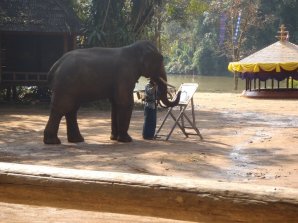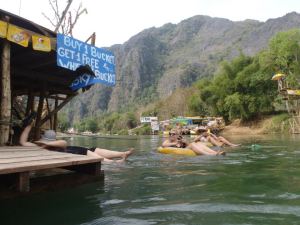The ‘True’ Elephant Attraction In Thailand: Chiang Mai Elephant Conservation Centre
March 28, 2012 Leave a comment
Bordering Lam Pang and Chiang Mai lies a care facility which shows the true love of animals that very much exists in the Thai culture. Forget the countless elephant tourist traps offered by Phuket and Kho Samui, here lies the true beauty of these magnificent creatures.
In the West elephants are often perceived with curiosity, as majestic beasts that inhabit distant jungles and bring us occasional delight through travelling circuses and zoos. However, in Thailand elephants play an enormous part in the country’s culture and way of life; representing the traditional symbol of power and peace and also acting as spiritual mentors.
The Thai people have connected with the curiosity that surrounds elephants in Western culture and have developed a range of tourist attractions such as elephant rides and shows-which have become an integral part of all tourist visits to the country. All parks will differ on what is offered, and it is generally recommended to head north if you want something more than just cheap thrills and a quick ride. There has been much controversy regarding the inhumane treatment of elephants in some of these centres and it is important to choose carefully.
One of the premiere Elephant Centres in Thailand is the Chiang Mai/Lampang Elephant Conservation Centre, located approximately one hour South of Chiang Mai and bordering Lampang. The Centre is managed by the Forest Industry Organisation, who successfully developed a sanctuary for elephants and an enriching cultural experience for visitors. There are no cheap tricks or cruel techniques here, and all elephants are encouraged to show-off their natural power and hidden talents in a supportive environment.
Elephants take riders for a bath at Chaing Mai Conservation Centre
What can you do?
Aside from the regular 45 minute elephant rides which will take you through the surrounding jungle of the Conservation Centre, there are numerous attractions that you will not find anywhere else in Thailand. The fantastic elephant show, which takes place three times daily, promotes the different skills of each elephant through a variety of tasks such as playing soccer, balancing on wooden planks and playing instruments. However, the undoubted crowd pleaser is the painting section at the end of the show. Here you will be dazzled as the elephants show off their brush skills by painting breathtaking portraits with their trunks. These are then auctioned off at the end of the show, with all proceeds being donated to the neighbouring Elephant Hospital.
Who ever said you need hands to paint a portrait?
Another unique attraction to the Chiang Mai Conservation Centre is the making of elephant dung paper, which means exactly how it sounds-paper made from elephant dung. Because of elephant dung’s large fibre content it is widely used throughout Thailand and here you will learn first-hand how it is made. For the more adventurous visitors, you will be given the chance to make your own dung paper with some help from your friendly instructors. But fear not, locals assure that the dung is 100% bacteria free and is surprisingly odourless for those with a weak nose.
Paper made from elephant dung? Why not
However, if observing is your forte’ you can enjoy learning not only how it is made but how the paper is used throughout Thailand. And why not purchase your own dung paper at the completion of your demonstration? A variety of styles and patterns are offered and are a great present idea for family, friends or loved ones.





